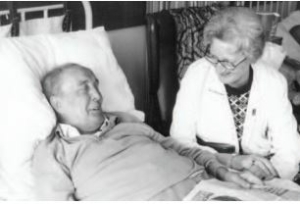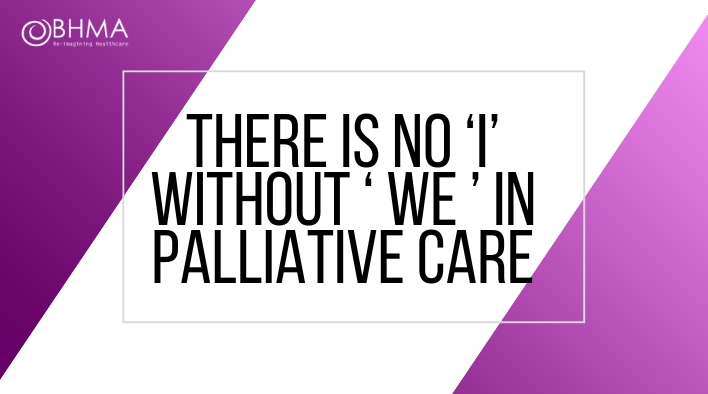There is no ‘I’ without ‘we’ in palliative care
Marina Malthouse, Retired palliative care physician
Published in JHH16.2 – Faith, hope and love in healthcare
After 33 years of practising medicine, I stopped working in order to pick up other interests in my life.Although I remain involved academically with the MSc in Palliative Medicine at Cardiff University as a marker and supervisor and with the New School of Psychotherapy and Counselling in London, I now volunteer in Greece for several months a year working with refugees, kitchen gardening with permaculture and cooking in a community. I have discovered how the skills of a doctor are eminently transferable to the outer world.
Faith, hope and love lie at the heart of palliative care. Dame Cicely Saunders founded this medical specialty through the modern hospice movement and although not present in the following lines, faith, hope and love infuse her often-quoted words:
You matter because you are. You matter to the last moment of your life, and we will do all we can to help you not only to die peacefully, but also to live until you die.
Not surprisingly the inescapable meaning emanating from these words have inspired both givers and receivers of palliative care for decades, because they insist that the essential elements of humanity remain consciously in place during the last chapter of people’s lives. Her endeavour was to seek a middle way that combined sound medicine with compassionate care (Clark, 2015). I owe 20 years of gratitude to this incredible woman, having entered the hospice environment as a novice in 1995 and exited as a passionate palliative care physician in 2015.
My place of work was Dorothy House Hospice near Bath. During every single one of those 20 years, I was learning from my relationships with patients, their families, and the people I worked with. They were my teachers and they had me sit through the classes of life. These encounters taught me – to name but a few things – about engaging with vulnerability, humility, the language of suffering, silence, humour despite adversity, intense sadness, eradicating assumptions, the individual and the collective, and curiosity. These lessons were not about gaining factual knowledge, but rather about acquiring a different kind of knowledge, a knowing that evolved out of engaging with suffering. In this line of work, suffering in the other needed to be met head-on. It infiltrated my own Other and as a consequence, shaped my mind, body and soul and over time, they adjusted my way of being.
 Many of these lessons were hard, and during my early years at the hospice, I became acutely aware of a need to broaden out beyond what I had learnt as a medical student and since qualifying as a doctor 13 years earlier. I realised that to attend to the emotional and spiritual pain of people who were dying, I would have to study about the borderlands between medicine and humanity and to become a more therapeutic practitioner, I would need to find ways to reflect on my way of being human. Working in an environment that had honed its own culture of care was not going to be enough if I wanted to do my job well. Faith, hope and a passion for my work were essential during the years spent studying for the Diploma in Palliative Medicine, an MA in Medical Humanities at Swansea University, and an Education Doctorate in Narrative Inquiry at Bristol University.
Many of these lessons were hard, and during my early years at the hospice, I became acutely aware of a need to broaden out beyond what I had learnt as a medical student and since qualifying as a doctor 13 years earlier. I realised that to attend to the emotional and spiritual pain of people who were dying, I would have to study about the borderlands between medicine and humanity and to become a more therapeutic practitioner, I would need to find ways to reflect on my way of being human. Working in an environment that had honed its own culture of care was not going to be enough if I wanted to do my job well. Faith, hope and a passion for my work were essential during the years spent studying for the Diploma in Palliative Medicine, an MA in Medical Humanities at Swansea University, and an Education Doctorate in Narrative Inquiry at Bristol University.
The hospice environment
Inspired by Cicely Saunders, hospices drew on her faith, hope and love and although ‘motivated by her Christian beliefs, Saunders harnessed the love of people of other faiths – and none – to a neglected cause…she opened up a practical, personal, political and philosophical space for engaging with the care of the dying, and with death itself’ (Clark, 2015).
The design of physical space inside and outside a hospice is consciously considered, but so too is psychologically safe space, in the ways that staff and volunteers attend to patients and their families. Hospices know it’s essential to support their staff in order to create an environment akin to a sanctuary, where people who are suffering in ways that they have never known can be ‘taken in’. At Dorothy House Hospice, this attitude extends out into the community where much of their work also takes place. The hospice defines itself by its ethos of hands-on care that attends to detail and practises a willingness to never give up however difficult the challenge. Hospices also make a point of not only supporting but also educating other professionals involved in end of life care.
Hospice as an organization
Organisational compassion is essential for a hospice. In their book Awakening Compassion at Work, Worline and Dutton define compassion as a felt and enacted desire to alleviate suffering, and they identify an organisation’s responsibility for enabling their staff to achieve this. Although healthcare workers have to be responsible for their own self-care both inside and outside of work, the demanding context of their work means hospices have a duty to work very hard at organisational compassion or at least they should (though no doubt this happens more in some hospices than others).
One could argue that in medicine, kindness is a basic necessity, yet the all-embracing kindness I experienced when I first entered into hospice care was something I hadn’t known in my previous places of work. Yet when it’s made explicit, a culture of kindness improves staff retention, while also helping ensure that patients receive the best care possible, and that staff work well as a team. Staff members who are unhappy at work detract from the quality of care, and may not show respect for one another or allow unhurried time with patients and their families that’s needed if they are to talk openly with patients and their families about death and dying. These are essential, and must be achievable aims in hospices, because people come there searching for the kind of help described by Ballatt and Campling in their 2011 book:
Intelligent kindness surely demands that healthcare staff are authentic and help patients towards the truth, even if very gently in some instances. By encouraging people to face the inevitable reality of death and think through and discuss various end-of-life scenarios, the unhelpful taboo on death may begin to lessen (p121)
I have no doubt that, because rooted in each of us was a desire to be authentic with the patients and their families we attended to, the people I worked with shared the common goal of compassionate care. This sense of kinship among us that arose from knowing that any one of our patients could be us, or someone close to us; from recognising and acknowledging that we were all human beings whose lives too would one day end in death. Within our organisation, safe space had to be created for this vulnerability to be expressed, and for trusting relationships to be nurtured. Achieving such intimacy is no easy task, neither in a staff group where strangers are meeting strangers, nor when patients and their families encounter unfamiliar healthcare staff within the hospice or in their community settings.
The practice within a hospice
During my last few years at the hospice, I started a writing group with a few nurses, another doctor, and our art therapist. Some of the group have left but we have newcomers, and so we continue to write. When we first started the group, as a way of bonding around our insecurities about writing we wrote of our experiences at work. I have included below three of my own stories that I’ve adapted for this article in the hope that they offer readers a window into the day-to-day life of a palliative care doctor working in and from a hospice. The stories are woven from an amalgamation of my experiences but the individual details are circumstantial and therefore anonymised. The first of these is about a patient and doctor meeting as strangers and how by engaging attentively, a different story of suffering emerges.
This next story aims to depict how putting faith in trust enables vulnerability to shift from a position of weakness to one of safety and strength.
The third story aims to show that conscious acts of compassion within an organisation enable faith, hope and love to be expressed and maintained against all odds.
Ultimately, it was the aim of Cicely Saunders for palliative care to be about healing so that by attending to the mind, body and soul, suffering is diminished.
Healing a person does not always mean curing a disease. Sometimes healing means learning to care for others – finding new wholeness as a family – being reconciled. Or it can mean easing the pain of dying or allowing someone to die when the time comes.
Saunders (cited in Lucas, 2018, p135)
For any discipline in healthcare, to achieve this kind of care new skills have to be learnt. This will entail, either formally or informally, a conscious noticing of ourselves in relation to others whether in situations where we are the carers or receivers of care. As Lucas (2018) has written:
Healing comes from within; a process of inner change away from suffering. Healing is not about curing. It is possible to die healed. It is also possible to be cured but not healed (p136).
Since leaving medicine in 2015, I have spent time in Greece volunteering in refugee camps where people from Middle Eastern countries who have run from war and torture are in search of a safe haven and a better life. I don’t think any readers will be surprised to hear that there are many overlaps between palliative care and this type of aid work where faith, hope and love all stem from the common roots of our humanity.
References
- Ballatt J, Campling P (2011) Intelligent kindness; reforming the culture of healthcare. Glasgow: RCPsych Publications, Bell and Bain Ltd.
- Clark D (2015) Works of love: Cicely Saunders and the hospice movement. Available at: Open democracy.net (accessed 6 April 2019). Lucas V (2018) On healing and palliative care. European Journal of Palliative Care 25(3) 134–7.
- Worline C, Dutton J (2017) Awakening compassion at work. The quiet power that elevates people and organisations. Oakland, CA: Berrett-Koehler.







